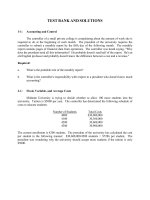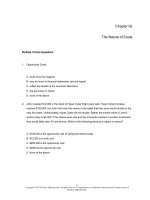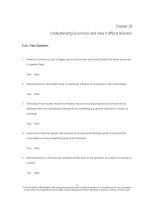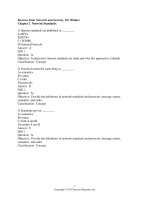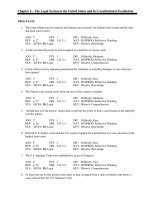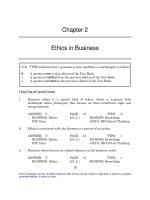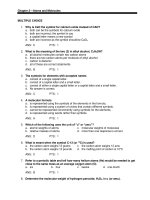Statistics for business decision making and analysis 2nd edition stine test bank
Bạn đang xem bản rút gọn của tài liệu. Xem và tải ngay bản đầy đủ của tài liệu tại đây (46.33 KB, 4 trang )
Chapter 2: Data
Quiz A
Objectives:
Organize data into a table with multiple variables (columns) and cases (rows).
Distinguish categorical from numerical variables. Be aware that some categorical variables (ordinal) define an
ordering of the cases.
Recognize time series data.
Identify when recoding or aggregating data are useful.
The camping permit at a state park asks that the person who is registering supply the following: Date, Name, Group
Size, and the Zip Code for the person filling out the permit. The park management maintains a data table that
records this information for each person who registers.
Section 2.1 – Data Tables
[Objective: Organize data into a table with multiple variables (columns) and cases (rows).]
1. On a particular day, 27 persons filled out a permit application. How many rows will be in the data table for that
day?
(a) 27
(b) 4
(c) 108
(d) 31
2. On a particular day, 27 persons filled out a permit application. How many columns will be in the data table for
that day?
(a) 27
(b) 4
(c) 108
(d) 31
Section 2.2 – Categorical and Numerical Data
[Objective: Distinguish categorical from numerical variables. Be aware that some categorical variables (ordinal)
define an ordering of the cases.]
3. Identify each piece of information by the type of variable it represents:
DATE
NAME
GROUP SIZE
ZIP CODE
Section 2.3 – Recoding and Aggregation
[Objective: Identify when recoding or aggregating data are useful.]
4. For a mid-summer report, the park manager decides to use the Zip Code to generate a column for the data table
that is labeled “INSTATE” with categories “Yes” and “No.” This column will identify the person registering as
being from within the state or from a different state. This procedure is an example of ______________ data.
(a) aggregating
(b) recoding
(c) time series
Copyright © 2014 Pearson Education, Inc.
Quiz A-2
Chapter 2: Data
(d) observing
5. At the end of the summer, the park manager creates a new data table using the information from each day’s
permit applications. The new data table consists of Date and the Total Number of Campers on that date. This is
an example of ____________ the data, and generating results in data that are referred to as a _______________.
(a) recoding; cross section
(b) aggregating; cross section
(c) recoding; time series
(d) aggregating; time series
Section 2.4 – Time Series
[Objective: Recognize time series data.]
6. The manager wishes to use the data table from question 4 to produce a graph showing the Total Number of
Campers for each day of the summer. What type of graph is most appropriate for this data?
(a) Bar graph
(b) Time Series
(c) Time plot
(d) Histogram
Section 2.2 – Categorical and Numerical Data
[Objective: Distinguish categorical from numerical variables. Be aware that some categorical variables (ordinal)
define an ordering of the cases.]
7. Each camper at the park is asked to fill out a survey which reads as follows: “We are interested in knowing
your return status. Are you planning to return to this park for camping next summer? Circle the number
corresponding to your response.” Campers are also asked to supply their Zip Code. The camper will circle one
of the numbers below, depending on their status.
NO
1
UNLIKELY
2
UNSURE
3
LIKELY
4
YES
5
The summary of the data from the responses consists of the “Zip Code,” and the “Return Status” of the camper.
What type of variable is “Return Status”?
(a) Ordinal
(b) Numerical
(c) Categorical
(d) Likert
Publishers track sales data from Amazon.com. Typical tracking variables include book purchased, date of purchase,
form of purchase (hardback, paperback, ebook, used), rating of purchase, and any comments
Section 2.4 – Time Series
[Objective: Recognize time series data.]
8. From the information provided, give an example of two variables that would result in time series data.
9. From the information provided, give an example of two variables that would results in cross-sectional data.
Copyright © 2014 Pearson Education, Inc.
Chapter 2: Data
Quiz A-3
Section 2.3 – Recoding and Aggregation
[Objective: Recognize time series data.]
10. An author wants to look at the Amazon.com data pertaining to her book. She creates a table that includes form
of purchase, the frequency of each form, and the total amount of purchase for each form. What is this an
example of?
(a) Aggregating the data
(b) Recoding the data
(c) Observing the data
(d) Graphing the data
Copyright © 2014 Pearson Education, Inc.
Quiz A-4
Chapter 2: Data
Answers:
1.
2.
3.
4.
5.
6.
7.
8.
9.
10.
A
B
Date – Ordinal; Name – Categorical; Group Size – Numerical; Zip Code – Categorical
B
D
C
A
Date of Purchase and an additional Variable (Answers will vary)
Answers will vary.
A
Copyright © 2014 Pearson Education, Inc.
